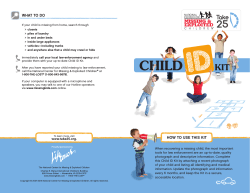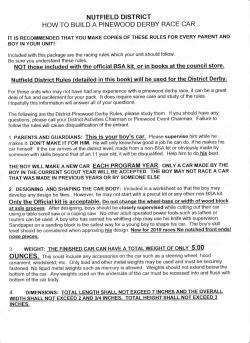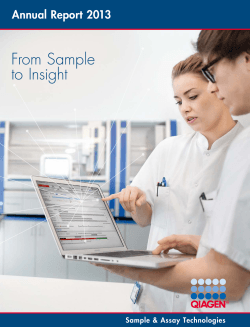
Importance of Sample QC
Importance of Sample QC Susana Wang, Kristi Spittle, Primo Baybayan Pacific Biosciences, 1380 Willow Road, Menlo Park, CA 94025 In-house QC: Case Study I Introduction NanoDrop Reading Single molecule sequencing places stringent sample requirements for sequencing on the PacBio® RS. Since amplification is not required, it is critical to maintain the highest sample quality in order to maximize sequencing. The introduction of the MagBead station with the PacBio RS addresses some sequencing challenges such as adapter dimer and short-insert contaminations, but it does not address problems associated with carry-over contaminants that could inhibit downstream sequencing. To increase success with your samples, we recommend several QC steps that you can perform prior to the construction of libraries. Here we present several cases on how to properly QC your samples upfront and provide additional sample purification steps which can help yield successful sequencing runs. Methods Before constructing SMRTbell™ libraries, it is important to characterize your samples as thoroughly as possible. The more information you have on your sample, the higher your success will be with PacBio RS sequencing. Here are the questions we ask our collaborators and customers, when we receive a sample, and the QC procedures we take to assess for contaminants. 1. What is the source of the DNA (bacterial, tissues, blood, etc.)? Knowing this information may be critical in upfront-QC steps. For example, if the sample is from plants known to have high polysaccharides, they may be co-extracted and a clean-up procedure may be necessary to remove them from the sample. 2. What methods were used for DNA isolation? Does the isolation method properly remove salts or detergents, such as CTAB, that may not be easily removed otherwise? If not, performing an additional clean-up step here may save a SMRT® Cell further downstream. 3. Have you performed quantitation using both Qubit® and NanoDrop® systems? Both quantitation methods have their advantages and disadvantages. If your sample quantitation is very similar on both the Qubit and the NanoDrop systems, then this may provide greater confidence that the DNA is pure. If the readings are different, it may indicate a possible contaminant. Even if the contaminant is not known, it will be easier to determine whether the results of an unsuccessful instrument run are due to the quality of the sample or the instrument performance. 4. Have you run gels to assess quality of the gDNA? It is important to know whether you’re working with RNA, DNA or degraded DNA. 5. Have you performed clean-up methods deemed necessary prior to shearing? It is best to clean up DNA prior to shearing. The cleaner the DNA is, the better your process will be. As can be seen, the more information you have on a sample, the better equipped you are for a successful PacBio RS run. Project: A set of five samples arrived from one of our customers. Project goal was de novo sequencing coupled with methylation analysis of all five samples. Tube Label Vol (μL) E 500 1 2 [ng/μL] 260/280 131.2 2 Amount (μg) A260/A280 A260/A230 A 16 2.060 2.043 B 24 2.000 2.037 C 21 2.082 2.047 D 50 2.130 2.070 In-house QC: Samples were rehydrated in 200 μL of EB Buffer (Qiagen®), we took our own readings as well as running a gel analysis. NanoDrop Reading Tube Label Vol (μL) [ng/μL] 260/280 Qubit Reading 260/230 Total ng [ng/μL] Total ng A 200 332.6 2.16 1.52 66520 26 5200 B 200 295.1 2.15 1.65 59020 21.6 4320 C 200 205 2.18 2.08 41000 13.8 2760 D 200 178.5 2.06 0.21 35700 37.6 7520 Figure 2: Example of a figure caption 1 2 RNA or ssDNA 3 4 5 1 = Lonza FlashGel® Ladder (0.1 to 4.0 kb) 2=A 3=B 4=C 5=D Lonza FlashGel system has a unique feature in which degraded ssDNA or RNA looks diffuse and orange in color whereas dsDNA (or total RNA) looks bold and yellow in color. Resulting Action: The 260/280 readings from our customer, our own readings, plus the gel all pointed toward RNA contamination and not gDNA. We did not proceed with SMRTbell™ library preparation after the QC assay, but instead asked that the customer re-isolate their gDNA. The second set of DNA passed QC and sequenced well. Case Study II Project: For this sequencing project, we wanted libraries that would produce the longest reads possible for hybrid assembly. Information from customer: • Sample was stored in a freezer for at least a year. • The sample was phenol-chloroform extracted and no other QC data was given. • This particular organism has an extremely poor reference due to its numerous and long repeats. 260/230 Total ng 1.74 65,600 [ng/μL] Total ng 36.8 18,400 1=E 2 = F (not important to Case Study Two) 3 = Lonza FlashGel® Ladder (0.1 to 4.0 kb) 3 Lonza FlashGel system with the Qubit and NanoDrop readings indicates the presence of RNA and degraded DNA. Information From Customer: • Samples were lyophilized with a heated vacuum • No gel pictures were provided • Below is the sample information provided to us: Sample ID Qubit Reading Resulting Action: Since there is only a poor reference genome for this organism, we went ahead and turned the entire smear into a library for Circular Consensus Sequencing (CCS). Library yield was 36%. Project is ongoing. Case Study III Project: De novo sequencing of a bacterial genome. Information from customer: • Bacterial genome of roughly 4 MB. • Two lyophilized samples with different methods of isolation: 1. Promega® Kit (G) 2. Homebrew isolation method (H) In-house QC: Samples were rehydrated in 200 μL of EB Buffer. NanoDrop Reading Tube Label Vol (μL) [ng/μL] 260/280 Qubit Reading 260/230 Total ng [ng/μL] Total ng G Kit 200 747.8 1.89 2.08 149,560 678 135,600 H 200 779.7 1.91 2.06 155,940 146 29,200 1 2 3 4 5 6 1 7 8 Left side of the gel was ran earlier than the right side. 1 = Lonza FlashGel® Ladder (0.1 to 4.0 kb) 2 & 7 = I (Sample is not associated with this case study.) 3, 5 & 8 = G (Loaded at different concentrations) 4 & 6 = H (Loaded at different concentrations) Lanes 7 & 8 contain sample that has been AMPure® system purified & concentrated. • Qubit® and NanoDrop® system results show that the sample isolated from the Promega® Kit (G) is mostly DNA, and the sample isolated using the In-House method (H) is mostly degraded DNA or RNA. • FlashGel® system data indicates H is actually completely degraded as no high molecular weight bands can be found on the gel. Resulting Action: • Sample H was not taken through library preparation. • Sample G was made into 10 kb and 1 kb SMRTbell™ libraries for Continuous Long Read (CLR) and CCS respectively. • A two SMRT® Cell sequencing run for the CLR library was completed in the PacBio RS to ensure sequencing yield prior to a larger run. Pacific Biosciences, PacBio, SMRT, SMRTbell and the Pacific Biosciences logo are trademarks of Pacific Biosciences of California, Inc. All other trademarks are the property of their respective owners. © 2012 Pacific Biosciences of California, Inc. All rights reserved. Importance of Sample QC Susana Wang, Kristi Spittle, Primo Baybayan Pacific Biosciences, 1380 Willow Road, Menlo Park, CA 94025 Recommendations / Discussion Case Study III continued Sample ID Yield Sample Name Cell # Reads G 30% G 10K Lib 1 7,742 0.9 K Lambda Ctrl 38% G 10K Lib 2 7,993 0.9 K Lambda Ctrl 1 40,836 The initial run shows that there is something in the sample inhibiting sequencing. Since we did not know the bacterial source of this sample and we did know that the sample was lyophilized, we tried a couple of purification methods to clean up the sample to improve sequencing. Two additional clean up methods were performed: 1. Phenol/chloroform extraction followed by ethanol precipitation (PC) 2. Qiagen® DNeasy® Kit (Q) Sample Yield Sample Name G 10K PC G Qiagen 1K G 1K PC Lambda Ctrl 1K 27% 26% 28% 30% G 10K PC G 10K PC G Qiagen 1K G Qiagen 1K G Qiagen 1K G Qiagen 1K G 1K PC G 1K PC G 1K PC G 1K PC Lambda Ctrl 1K Lambda Ctrl 1K Lambda Ctrl 1K Lambda Ctrl 1K Cell # Movie 1 2 1 1 1 2 1 2 1 2 1 2 1 2 1 2 1 2 1 2 1 2 Reads 20859 26183 28063 21637 26458 18799 40139 32725 46875 45916 44043 40223 41886 39696 The sequencing results from this study show that both purification methods increased the loading from the original 7 kb reads. However, the phenol/chloroform extraction improved the sequencing yield the most. MO BIO® PowerClean® Kit It is known that phenol/chloroform may cause problems with downstream sequencing when phenol is not completely removed. See the poster “Sample Quality-Effects of Contaminants on SMRTbell™ Library Preparation and Sequencing.” The MO BIO® PowerClean® Kit was also looked at as an alternative clean-up method. The PowerClean Kit is supposed to remove a variety of contaminants including polysaccharides, poly-phenols, and heme. These qualities add to the kit’s attractiveness in that it can remove other contaminants that phenol/chloroform is unable to remove. For this project, the sample was cleaned with the MO BIO PowerClean (MBPC) or an AMPure kit (AMP) prior to shearing. Sample Yield Sample Name Cell # Reads G 10K MBPC G 10K AMP 43% 44% G 10K MBPC G 10K MBPC G 10K AMP G 10K AMP 1 2 1 2 39463 38804 19622 21155 In this poster, we demonstrated 3 different cases showing the importance of performing sample QC, and described different sample clean-up methods. Here are some of the methods used in the case studies, and the advantages and disadvantages of each of the methods. Clean Up Method Advantages Disadvantages Qiagen® Column • Quick, easy, convenient. • Yields can vary ® (DNeasy / • Can be used on final greatly ® QIAquick ) SMRTbell™ library • Yields are very • consistent. Often >90% recovery of DNA Phenol / • Common protocol and Chloroform removes a variety of • Extraction and contaminants Ethanol • Can be time-consuming, Precipitation taking at least a few hours • Can be used on final SMRTbell™ library • Yields are very consistent. Often >90% recovery of DNA • • No extra kit purchase ® AMPure required Beads • • Scales more easily for large amounts of DNA. • Can be used on final SMRTbell™ library • Needs a hood to perform phenol/chloroform extraction If not properly cleaned, carry over phenol may negatively impact sequencing Figure 2: Example of a figure caption Will not remove • MO BIO® • PowerClean® kit • • many contaminants Requires an extra AMPure step Recommendations / Discussion Case Study Tw continue… The general observation has been that the cleaner the gDNA, the better the quality of the library. Therefore, the earlier the purification is done, the better. In some instances, a simple AMPure® kit cleanup on the gDNA can improve even the fragmentation process. Below is a workflow to indicate at which step various clean up methods can be used. gDNA Fragment DNA & Concentrate • Any and all method of clean up can be used at this point • It is best to perform cleanup prior to fragmentation SMRTbell™ Library Prep Final SMRTbell™ • QIAquick® kit • AMPure® kit • Phenol/chloroform extraction – follow with an additional AMPure® kit purification Primer Annealing Binding & Sequencing • QIAquick® kit • AMPure® kit • Phenol/chloroform extraction – follow with an additional AMPure® kit purification **If purification is performed at this point, it is important to redo primer annealing As longer-insert libraries are sequenced on the PacBio RS, clean, high-quality DNA will become more and more critical. The best approach is to start with an effective DNA isolation method. It is then important to know the quality of the sample so that the appropriate clean up steps can be performed to remove contaminants. Does not scale for multiple samples or Readily available kit large amounts of designed for re-purifying DNA extracted gDNA • Average yield tends Clean up takes about to vary between 2030-45 min 50% No hood required • Cannot be used on Removes a variety of final SMRTbell™ contaminants library due to damage caused during the clean-up Pacific Biosciences, PacBio, SMRT, SMRTbell and the Pacific Biosciences logo are trademarks of Pacific Biosciences of California, Inc. All other trademarks are the property of their respective owners. © 2012 Pacific Biosciences of California, Inc. All rights reserved.
© Copyright 2025


















